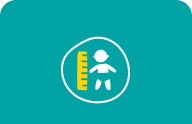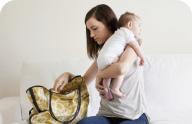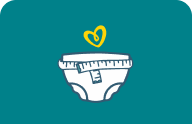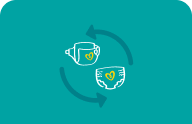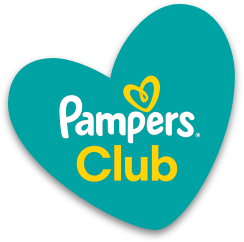How to Bathe Your Newborn
Your baby’s first bath is not only one of the earliest milestones but also a moment to treasure. Although bathing a slippery, squirming, and sometimes screaming baby takes some practice, it will get easier with every bath.
Read on to learn all about when you can give your newborn a bath , how to bathe a newborn baby with the umbilical cord stump , and how often your little one may need to be bathed during these first few months.
How Often Should You Bathe Your Newborn?
You may be surprised to learn that your newborn doesn’t need that many baths. Giving your baby a bath three times a week is plenty if you make sure to clean the diaper area well during each change. Need help? Here's a helpful guide on diaper changing.
It’s best not to give daily baths because frequently bathing your newborn may dry their skin.
When Will Your Baby Be Ready for His First Tub Bath?
Many parents wonder, "When can I give my newborn a bath? " After your baby’s umbilical cord stump falls off, you can transition from sponge baths to actual baths in a sink or a baby bathtub.
Their first bath in a tub should be gentle and quick; however, you might need to go back to sponge baths if your baby fusses a lot and simply doesn’t like this new activity. Learn how to clean your baby’s eyes, ears, and nose, as this is a delicate area for your newborn.
Can You Bathe Your Baby While the Umbilical Cord Stump Is Still Attached?
During your baby’s first few weeks, while the umbilical cord stump is still attached, you should only give sponge baths.
A sponge bath is as simple as wrapping your baby in a towel, and wiping her with a damp washcloth and soapy water. You’ll want to do this on a comfortable surface such as a changing table. Keep your baby wrapped in the towel, bathing one part at a time.
The umbilical cord stump typically falls off in a few weeks. If it stays on longer than that, you might want to check with your baby’s healthcare provider.
You’ll want the umbilical cord stump to dry up and fall off on its own, which is why only sponge baths are recommended until that time. After the stump falls off, you may start to notice your little one has an adorable innie or outie belly button.
How to Give Your Baby a Bath
Get everything ready before you start your baby's bath:
Ensure that all the supplies you need like shampoo, soap, a hooded towel, and a cup for rinsing are within arm’s reach—never leave your baby unattended in the bath, so make sure you have everything you need on hand, including your baby’s fresh change of clothes.
Make sure the room is warm before undressing your baby.
Follow these step-by-step guidelines for bathing your baby:
Line a sink or baby bathtub with a towel and fill it about 2 inches full of warm water (around 100 degrees Fahrenheit)—test it with your elbow or the inside of your wrist to make sure it’s not too hot.
While supporting your baby’s head with your non-dominant hand, use your other hand to guide them into the water feet first. You’ll want to do this swiftly so they don’t get cold, and you’ll want to make sure their head and most of their body are above the water level.
Wash their body from top to bottom with clear water and, if you prefer, a mild baby soap. Keep them warm by pouring warm water over their body using a cup. Use a soft cloth to wash their face.
If they have hair, it’s enough to shampoo once or twice a week. When you do, massage a drop of mild baby shampoo into their scalp, even the soft spots (fontanelles) of their head. Be careful not to get any soapsuds or shampoo in their eyes—cup your hands over their forehead when rinsing their head. If some soap or shampoo does get into their eyes, go ahead and wipe them using a cloth dampened with clear water.
After bathing and toweling off your baby, it’s a good idea to moisturize their skin with a fragrance-free hypoallergenic lotion. This step can help prevent dry skin or even eczema.
If your baby has cradle cap, a skin condition on the scalp that results in scaly skin, bath time is a good opportunity to brush their scalp while shampooing their hair.
Remember, during bath time, if by chance you forget something, don’t leave your baby unattended in the bath water. Lift them out of the sink or tub and take them with you.
When Is the Best Time of Day to Give Your Baby a Bath?
There is no one perfect time to give your baby a bath—it’s your decision. Choose a time when you’re least likely to be interrupted and when your baby is calm.
You may like to give your baby a bath in the daytime because they’ll naturally be more alert. Or you may include bath time in your baby's bedtime routine.
If you plan to give your baby a bath after feeding them, wait a while to ensure their tummy has had a chance to settle.
Can You Give Your Baby Bath Toys?
Keep in mind that for infants, you don’t need any bath toys at all, as splashing around in the water will be enough entertainment. As your baby gets older, you can add some floating baby toys or even waterproof books to keep them occupied.
The Bottom Line
Eventually, your baby will start to enjoy baths, and at some point, it will become more like playtime than bath time. Understanding how to bathe a newborn with an umbilical cord and knowing when you can give a newborn a bath can make this transition smoother and more enjoyable for both of you. When they’re bigger, let your little one splash around and have some fun in the water (with adult supervision, of course).
Between your baby’s baths, you’ll probably be doing a lot of diapering. Why not get rewarded for all your efforts? Download the Pampers Rewards app and for every purchase, you’ll earn points that you can redeem for rewards.
How we wrote this article The information in this article is based on the expert advice found in trusted medical and government sources, such as the American Academy of Pediatrics and the American College of Obstetricians and Gynecologists. You can find a full list of sources used for this article below. The content on this page should not replace professional medical advice. Always consult medical professionals for full diagnosis and treatment.
Join a World of Support
through Pregnancy and Parenthood.
TRACK WITH TOOLS
LEARN WITH EXPERTS
GET REWARDED



